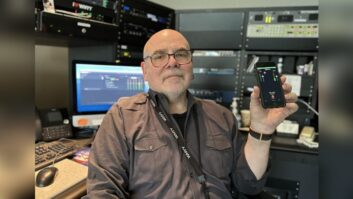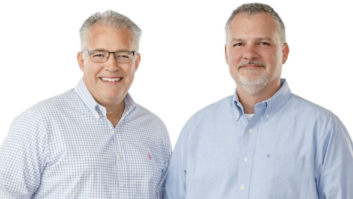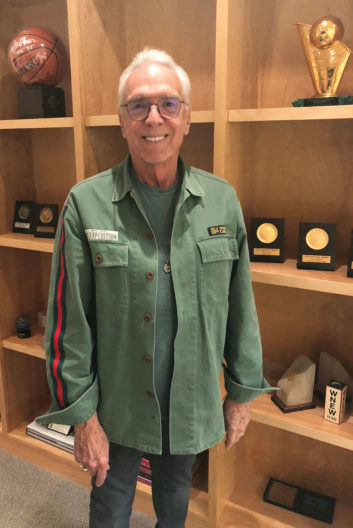
PodcastOne, founded in 2013, positions itself as “the leader in digital on-demand spoken word audio” and “one of the few pure plays” in the podcasting space. Its stable of talent includes Adam Carolla, Laura Ingraham, Shaquille O’Neal, Dan Patrick and numerous others, in a network of more than 200 shows.
The podcasting company was founded by Norm Pattiz, who was already a legend in radio and media circles for having created and led Westwood One. Radio World caught up with Pattiz recently to ask about the biggest challenges his company faces, where he sees PodcastOne going and how he feels podcasting has affected his former industry.
Radio World: Podcasting has had a remarkable arc in 15 years. Can you capture where you think the industry is in its life span?
Norm Pattiz: The growth of PodcastOne is remarkably similar to the growth of Westwood One when I founded the company. We started off with a little bit; in the case of Westwood One, I think, we had $150,000 worth of business. In the case of PodcastOne, we started out with a million-and-a-half dollars’ worth of business, and today, we’re well up into the tens of millions, which is where Westwood One was at a similar time. Then a few years later, Westwood had $600 million worth of business, went public and wound up with a $4 billion market cap.
I don’t know whether I’ll be around to see that because I’m considerably older; but that’s where I think that PodcastOne is going, reflective of the overall growth of podcasting. And the similarities will be when PodcastOne hits the same inflection point that network and syndicated radio reached — when rather than evangelizing and building support, we become a part of the overall media mix.
[Seven Myths Broadcasters Believe About Podcasting]
RW: So you’re a believer that the growth is yet to be fully realized.
Pattiz: Oh, I don’t see any cap on the growth, quite the opposite.
Let me say this first. I’ve been a cheerleader for radio for 45 years; I’m not changing now. But I think the fastest-growing segment of audio is going to be podcasting, because it’s not limited to simply the formats that exist on radio; you don’t have to find your radio station to listen to it; you can consume it anytime, anyplace, anywhere.
Programming in network and syndication, you’d [need] a certain amount of consumption that would be have to be relatively large. In the podcasting area, what you need are active and committed consumers and listeners.
This has been proven in the direct response market. But now brands are getting involved; where we used to be 90% direct response advertising when we started, we’re now about 50/50 direct response to brand advertisers.
There are too many great selling points to overlook. The podcast listener is the most committed listener in the audio or video medium. A recent study showed a 61% conversion rate for podcast listeners to products that are host-read and advertised on podcasts. I mean, that’s amazing.
RW: Yet I imagine there are perceptions about the market and the platform. If I’m a P&G or a Ford, I might sense that audio is hot, yet I might look at the total for podcasting and think there’s so many different offerings, and it’s not well developed in terms of audience measurement. … What objections do you hear from those kind of advertisers?
[Infinite Dial: Podcast Listening Now a Majority Behavior]
Pattiz: I’ve never heard that kind of argument. I’ve certainly have heard questions relating to measurement, which is one of the reasons why at PodcastOne we spent a lot of money building a back end that can provide audience measurement any way the advertiser wants it.
Whether it’s the way they currently buy radio or television, using gross impressions, or going through the digital door and using uniques, we can pretty much supply that number; we can use the IAB standard. We’re in a situation that as the marketplace remains in flux, we don’t lose business because our platform doesn’t deliver the metrics that the advertiser wants.
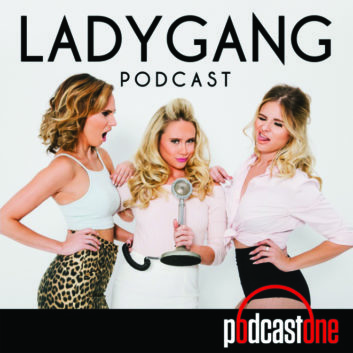
We do business with third-party suppliers. We can give them survey research through Edison; we can give them download research through Knox and Verizon, who measures raw downloads; we can convert the raw downloads, filter them and convert them in to filtered downloads. We can deliver really any way that an advertiser wants.
When you compare podcast measurement to syndication or network radio, there are some sources that people are more comfortable using for radio and for radio syndication; but they’re phenomenally unsophisticated, and the word “estimate” is very much in view when those numbers are being supplied.
“Estimate” is what’s used no matter what service you use: They’re audience estimates. Though people talk about a universal measurement for podcasting, as long as there’s so many companies using their own technology to count those numbers, I don’t think we’re close to that.
But then again, RADAR in network radio was never a very accurate way of measuring audience. Some of the surveys that are used when buying sports inventory or special events, sometimes those services do overnight ratings with about a hundred people. How accurate can that be?
[Pro Audio Answers Podcasting’s Call]
Of course, people have [long] been complaining about survey research and call-out research and the latest overnight ratings — it’s endemic to media companies, whether they’re digital or not, people are always questioning the research.
When I was working in the television business, every time we got a lousy book we would find a reason to discredit it; and every time we had a good book this was the most accurate survey that had been taken in the history of television! I don’t see [measurement concerns] stunting the growth of podcasting in any way.
RW: What are other misperceptions among the advertising community or general public that you would like to see overcome?
Pattiz: The consuming public is just getting it. When you take a look at the number of people who have consumed podcasts — at one point when we started six years ago, it probably wasn’t even 20%. Now it’s either pushing or slightly over 50%. And when you take a look at the average time spent listening, it’s way more than any competitive medium. Even Apple, with the limited research that they release on podcasting, last year said that the average time listening to a podcast was 48.3 minutes. And when you consider that some of the podcasts that they were measuring probably didn’t even run that long, I think that’s pretty outstanding.
If a buyer is buying a million viewers on television or a million listeners on radio or a million consumers through a podcast, podcasting should be worth more because those people had to perform a positive act to get there in the first place.
[NPR’s Sucherman Seeks Digital Partnerships]
The biggest problem is educating advertising agencies and advertisers. They’re not used to it. So we have to go out there and evangelize and then build demand. That’s the stage we’ve been in.
It’s not often somebody who tests the medium doesn’t wind up using it more.
RW: Is there a difference between what makes good, compelling content in podcasting versus what makes good, compelling content for a Westwood One radio?
Pattiz: It’s entirely different. All of the research shows with people who consume radio are not the same people who consume podcasts.
Now, that could change, with iHeart getting into the business and with Cumulus getting into the business. But they’re learning very quickly — I could cite the iHeart deal with “How Stuff Works” — you can’t just go in there and say you’re the biggest because you’re repurposing your radio shows. Nobody’s gonna buy that. It’s not true. They have now gone out to try and get podcast-specific programming. And if they, in fact, do promote across their radio, that could drive more consumption of radio listeners to podcasts. But right now, I haven’t seen it happen.
Most radio companies, they’re seeing people do well in podcasting such as ourselves and others, and they think, “Well, we should be able to do this, look at all of our content and look at all of our resources.” Even though resources is probably not the best word to use for radio major companies these days.
They’re learning. I see them making many of the same mistakes that we made when we first started. But we overcame them, and I’m sure they will too.
[From 2015: Is This the Golden Age of Podcasting?]
In terms of the competition, we’ve got 300 podcasts on our network. I could have 3,000 tomorrow. But since our programming is generally partnerships between the network and the producer — and of course, we produce a lot of our own stuff — I’m not interested in filling our network full of programs until everybody’s making money.
RW: These are remarkable times for people who believe in audio. For a radio broadcaster watching the development of podcasting, what do you think should be going through their mind about the relationship of the two?
Pattiz: Radio broadcasters should pay a lot of attention. They certainly are corporately, and I think they are well down the ranks.
In our partnership with Hubbard, which owns almost 31% of PodcastOne, we have been doing some work on the local level; and they’ve been supplying us with programming, both original podcasts and programming [from] very popular time periods on their stations.
The economic impact of being able to provide the kind of data, and the ability to digitally insert, and the kinds of things we’ve been able to do — being used by a major radio group has proven to be very valuable. Some of their podcasts develop audiences that are big enough to be packaged in with our biggest national programs. Others simply provide an on-demand audience that can be sold locally, along with the regular average quarter hour of the time period, to bring in new audience and new revenue for little or no cost.
We have some repurposed radio programming on our network … but the strength of podcasting is original content.
[Radio Seeks to Strengthen Podcast Connection]
One case in point: We had the Laura Ingraham radio show for many years; I’ve had a relationship with Laura for 17 years going back to Westwood One. Now Laura is no longer doing a radio show, she is doing multiple podcasts during the week; and the size of her audience, after having been on only three weeks [as of early February] is four to five times the size of her audience in radio.
That’s because the way that radio groups function right now is that the big ones control the major markets. If you’re an independent, even if you’re distributed by that radio network, all of those programming decisions are still made locally. In the case of Laura, she’s been on for a very long time but was weak in the top 10.
Well, she’s not weak in the top 10 anymore; and when she mentions her podcast on her Fox TV show and we start using all of our network programming to promote new shows, special events and what have you — because we have the right to promote in unsold inventory on every show that’s on our network — that combination is a tough one to beat.
There will be more and more interaction between radio and podcasting.
[How Technology Helps Radio and Its Listeners]
For the radio talent? Where radio and other big media companies paid little or no attention to podcasting, now if you go to work for them there’s a high likelihood that your podcast rights will be part of your deal — even though they may never, ever do a podcast. But using the misconception that their popularity in radio is what’s driving the interest of anybody wanting to put them in a podcast network, so that they can get a piece of the action. You see that everywhere. It’s not unusual to see it creep into podcasting.
RW: Do trends in consumer use of technology affect this? I’m thinking for instance about smart speakers and how dramatically that’s come on in the last two years.
Pattiz: Absolutely. Our programming is compatible with both the Apple speaker and the Android speaker. What you have to do is you have to identify the program, currently, by who distributes it. So you’d have to say “Go to PodcastOne. Go to Adam Carolla.”
One step too much. And that’ll be solved quickly. It shouldn’t be more than “Hey, I wanna listen to Adam Carolla’s program last Thursday.”
RW: It sounds like you definitely feel like we’re nowhere near seeing the full story of podcasting written.
Pattiz: Oh, no, not even close. When I left Westwood One, they asked me if I would form a consultancy or a boutique that would keep the talent that I had relationships with still in the Westwood One camp, and of course, I did that.
[Radio Keeps Dying But Someone Forgot to Tell the Listeners!]
When a mutual friend of mine introduced me to a young man named Kit Gray who was repping podcasts out of his apartment in Marina Del Rey with his dog, and I saw what he was doing on a very, very small scale, I thought, well, this is just the digital version of Westwood One, with so many advantages it’s tough to count them all.
I had no desire to go back into business; I’d had a pretty successful business career. It certainly wasn’t about the money. But the thing that was nice about the money was that I didn’t need any partners, I could fund this myself. So we did, and it’s just been a great ride ever since.
I think the entrance of PodcastOne was one of the inflection points that pointed out the ability that podcasters have to go to national advertisers if they have a variety of programs in their mix.
I couldn’t go in and start evangelizing podcasting unless I had offerings in every category that was on iTunes. Otherwise, I’d be going in and saying podcasting was great, and somebody would ask me for something I didn’t have. Before we hit the streets or went to Manhattan, we were making sure that we had program offerings in every category that an advertiser could want.
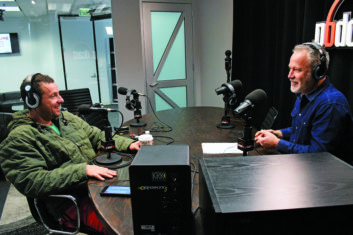
RW: Anything else we should know?
Pattiz: I still get asked to speak at a lot of radio functions. From the very beginning, I have said: What radio needs to do is embrace digital, whether it’s podcasting or streaming or what have you. Because radio has had a history of growing every year, for a very long time, until recently.
[Radio Seeks Its Future in the Vehicle]
I said that by adapting digital, as part of audio, part of radio, you’re going to see your business start growing again. That pretty much fell on deaf ears at the highest level until a couple of years ago. Now we see radio companies getting involved.Most of them are dipping their toes.
Hubbard was the company that recognized the opportunity. The investment they made in the company could still be classified as dipping their toes [but] it was a larger investment than any radio company that I knew of had made in podcasting.
So we were encouraged then; we’re encouraged now. I see that there’s been press about Gimlet possibly getting bought by Spotify for $230 million. Boy, do I hope that one closes! [Spotify announced the deal shortly after this interview.]
RW: You put a lot of work in to get to this position.
Pattiz: Yeah. And we’re bigger!
A lot of deals that are being made involve bigger production guarantees, bigger fees to name talent. We haven’t gotten caught up in that; we like the idea of partnerships. Even though we could make bigger guarantees, we think that the personalities that we’re working with, if they’re hugely successful in other mediums, that no matter what podcasting has to offer them it’s probably going to be at the lower end of the priority list.
We like the idea of being partners with them so that they’re as committed to the success of the podcast as we are; it’s not just a big check that their agent brought them, and they’re going to wind up having to cancel shows because they just got a movie or something.
All of that stuff will work itself out over time. But right now it’s a very interesting and exciting medium. Over the next few years, more will be revealed.








